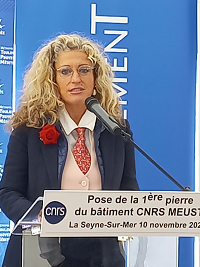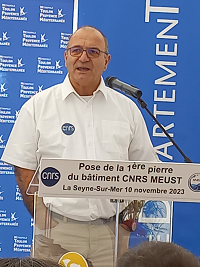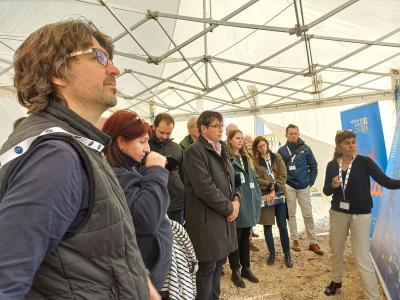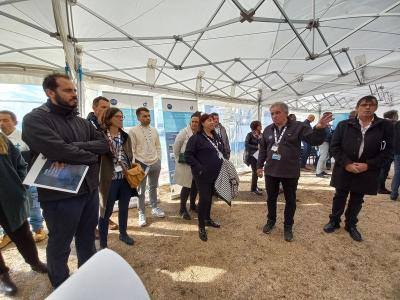Photo credits: Sketch by Jean-Michel Gomez, BBG Architectes
Le 10 November 2023 Antoine Petit, Chairman and CEO of CNRS, Nathalie Bicais, Mayor of La Seyne sur Mer, Jean-Pierre Giran, President of the Toulon Provence Méditerranée metropolitan area, laid the 1st stone of the CNRS MEUST building in La Seyne sur Mer, Laëtitia Quilici, Vice-President of the Var Departmental Council, Jean-Jacques Fourmond, CNRS DT-INSU Director, Cyrille Flamant DAS-INSU, Vincent Rigaud - Director of the Ifremer Méditerranée Centre, Cristinel Diaconu, CPPM Director and Valérie Michotey, MIO Director.
 |  |  |  |  | |
 |  |  |  |
CNRS MEUST: Mediterranean Eurocentre for Underwater Sciences and Technologies
A tool for instrumental innovation in marine science research and observation
The future MEUST building will house part of the activities of the Technical Division of the Institut national des Sciences de l'Univers (INSU), whose mission is to design, develop and coordinate national and international research in astronomy, Earth, ocean, atmospheric and space sciences.
The institute's scientific themes :
- oceanography
- geology
- geophysics
- climatology
- hydrology
- volcanology
- seismology
- environment
- planetology
- astronomy
- astrophysics
The DT-INSU is an essential UAR (Unité d'Appui et de Recherche - Support and Research Unit) of the INSU, supporting instrumentation for research and observation in 3 areas: R&D, Design Office, Instrumented Parks. Its staff have internationally recognised expertise in the following fields: deep-sea and airborne (aircraft/balloon) instrumentation, lidars, etc.
The DT-INSU has around fifty staff spread over 3 sites (La Seyne, Gif-sur-Yvette and Plouzané) as well as around twenty sailors spread across the coasts of mainland France (Channel, Atlantic and Mediterranean).
It has 3 missions:
- emerging or innovative instrumental developments:
- forward-looking initiatives on generic and emerging technologies
- innovative developments generic platforms for the deployment of field sensors, disruptive technologies, low-cost, frugal, open source, sustainable instruments, etc.
- support for the structuring programmes of the INSU and other institutes and organisations:
- The expertise of the DT-INSU can be mobilised to provide support in setting up instrumental projects (specifications) submitted by laboratories (EquipEx+ Programme, Priority Research Programmes or PEPR, IR Research Infrastructure, IR* Very Large Infrastructures National Observation Services, CNRS Calls for Projects, Priority Actions, etc.).
- specific technological support for these projects (innovation, prototyping, etc.)
- support for the provision and deployment of operational tools:
- National parks (oceanographic instruments, continental coring) involved in international projects contributing to the influence of French research
The construction of the MEUST building will give a boost to shared interdisciplinary activities in the field of marine and underwater technologies:
- boost the visibility and influence of the CNRS in a strategic region (the Mediterranean) through national and European projects that are interdisciplinary, inter-organisational and ambitious
- to develop, with the support of the INSU Technical Division (DT-INSU), innovative strategic instruments for CNRS in the field of marine sciences
- Support for government programmes under the PIA and France 2030 (EquipEx+ DeepSea'nnovation and MARMOR), PEPR Grands Fonds, .... in particular in partnership with Ifremer and regional research laboratories.
- Support for quality and environmental responsibility (relevant emerging, low-impact and sustainable technologies) for marine instrumentation
- Developing local partnerships with manufacturers in the sector
- strengthen, via the involvement of the DT-INSU, the technical support to the Côte d'Azur units (MIO, Géoazur, LOV and OOV) for the campaigns at sea carried out from the oceanographic ships known as "stations" within the framework of recurrent observations (National Observations Services labelled CNRS and research infrastructures (EMSO, etc.))
- supporting the implementation of the KM3NeT (Cubic Kilometer Neutrino Telescope) and EMSO (European Multidisciplinary Seafloor Observatory) subsea infrastructure and seafloor observatories
- home of the underwater observatory data acquisition and control centre
- welcome scientists working on the interdisciplinary exploitation of observations acquired as part of IR, seabed and water column observatories, campaigns at sea, etc.
- recognised excellence and expertise of the CNRS (Earth & Universe and Nuclear & Particles)
- to encourage the emergence of new interdisciplinary scientific initiatives to contribute to the societal challenges set by the CNRS COP, particularly with regard to climate change in the Mediterranean
- strengthen partnerships with Ifremer, Aix-Marseille University and the University of Toulon, and create a genuine marine campus, with the support of the world-class Pôle Mer Méditerranée competitiveness cluster
- create new opportunities for entrepreneurial innovation around marine sciences, as well as start-ups at the cutting edge of underwater technologies
Contacts : Jean-Jacques FourmondDirector of the DT-INSU - More information
Côte d'Azur laboratories with direct links to the DT INSU
Mediterranean Institute of Oceanology / MIO
M.I.O is a multidisciplinary oceanology research laboratory with 240 staff from the Universities of Aix-Marseille and Toulon, the CNRS and the IRD. It is part of OSU Pythéas. Its objectives are to gain a better understanding of the oceanic system and its evolution in response to global change. In particular, the MIO has been working on understanding deep-sea environments at the 'Ligure-Ouest' site of the EMSO network, at a depth of 2,450m off Toulon, for some 20 years, as well as on various Atlantic ridges. In the Mediterranean, high-frequency temporal monitoring of physico-chemical properties along the water column, the dynamics of marine currents and mesoscale events, the production of phytoplankton at the surface, the flow of particles from the water column that sink to the bottom, and the diversity of organisms all help to establish the link between the production and storage of CO2 at the surface, and its export and sequestration at depth.
Contact : Valérie Michotey, Director of the MIO – More information
Marseille Particle Physics Centre / CPPM
The Centre de Physique des Particules de Marseille is part of the CNRS/Institut national de physique nucléaire et de physique des particules (IN2P3) and Aix-Marseille University. The research carried out at the CPPM is at the crossroads of the two infinites - the infinitely small and the infinitely large - from the study of the elementary components of matter to the exploration of the cosmos. To do this, we design and build state-of-the-art detection systems, often operating in extreme conditions: under the sea, in space or underground. Most of our research is carried out within leading international collaborations, and our contributions are recognised worldwide. We are involved in training young people in research and through research, in university teaching, in disseminating scientific culture to the general public and to young people, and in promoting our results.
The CPPM is the host laboratory for the Provence Méditerranée Submarine Laboratory (LSPM) and for the KM3NeT underwater neutrino detector.
The LSPM is a national platform of the CNRS's Institut national de physique nucléaire et de physique des particules (IN2P3). Aix-Marseille Université (AMU) and Ifremer are involved in managing this infrastructure, which is geared towards multidisciplinary research and scientific culture. The LSPM has also been awarded the "Plateforme technologique AMU" (AMU Technology Platform) label in order to structure the skills on offer and make them more easily accessible to the socio-economic and academic worlds.
The LSPM is home to a giant underwater neutrino detector belonging to the KM3NeT (Cubic Kilometre Neutrino Telescope) international collaboration. It is dedicated to the search for high-energy neutrinos originating from cataclysms in the Universe such as supernovae or the formation and evolution of black holes. It will also enable revolutionary measurements to be made of the physics of neutrino oscillations.
The oceanographic component hosted by the LSPM belongs to the network of underwater observatories of the European research infrastructure EMSO-ERIC (European Multidisciplinary Subsea Observatory). Located in the seas around Europe, the various sites in the network are used to study the impact of global warming on the oceans around Europe, as well as deep-sea ecosystems, with a view to fundamental research and sustainable management.
KM3NeT and EMSO-ERIC are identified as priority projects in the European ESFRI roadmap and have been funded by the European Union for their preparatory phases.
Contacts : Cristinel DiaconuDirector of the CPPM, Paschal CoyleDirector of the LSPM and spokesperson for the KM3NeT Collaboration. Pascale KellerLSPM operational manager - For more information: www.cppm.in2p3.fr – www.lspm.in2p3.fr
Financial and project support partners
In addition to the CNRS, the municipality of La Seyne sur Mer, the TPM metropolitan area, the Var department and the Southern Region are supporting and have contributed to the funding of the CNRS MEUST building.
The budget for the MEUST project is approximately €9.5m, broken down as follows:
- CD83 €1,750,000
- TPM €1,750,000
- Southern Region €500,000
- CNRS €5,467,000
Press contact: John Pusceddu l Communication CNRS Délégation Côte d'Azur l Tel: 06 84 09 31 90
















